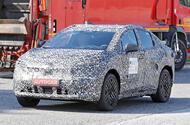The third-generation electric family car is a UK-built baby Ariya that will major on efficiency
The third-generation Nissan Leaf has been spotted testing for the first time ahead of production getting under way in Sunderland next year.Â
Morphing from hatchback to crossover, the next Leaf is one of three electric SUVs – alongside replacements for the Nissan Juke and Qashqai – due to start running down the lines at Nissan’s UK factory by the end of the decade.
Production of the previous Leaf ended in March this year, and while Nissan has yet to confirm a launch date for its successor, it's understood to have begun production trials in the summer and could be in production as early as spring 2025.Â
The Japanese firm has previously given an indication of what to expect from the next Leaf with the Chill-Out concept - a sleek, minimalist compact SUV touting high levels of digital functionality and advanced autonomous driving capabilities.Â

The production car looks to remain true to the concept’s overall silhouette, clearly aero-optimised in a bid to maximise range, but it seems to sit closer to the ground and have more conventional LED light signatures at each end, rather than digital graphics.
Proportionally, it’s a clear relation to the larger Nissan Ariya, with which it will share a modular EV-specific platform previously known as CMF-EV and now dubbed Ampr Medium.
Notably, Nissan’s Alliance partner Renault uses that architecture for the similarly sized Scenic EV, which could give clues as to what to expect of the batteries and powertrain options.
The Scenic can be had with either a 60kWh or 87kWh battery – for official ranges of 260 or 379 miles respectively – and a choice of either a 168bhp or 215bhp motor on the front axle.
It remains to be seen if Nissan will equip the Leaf with an optional second motor on the rear axle, as it does for the Ariya e-4orce, which produces up to 389bhp in standard form or 429bhp in tuned-up Nismo guise.Â
It’s expected to be a close match for the Ariya inside, too, with a minimalist dashboard topped by a wraparound digital interface and a row of haptic buttons in the dashboard for the climate control.
It could also get the larger car’s optional sliding centre console, which makes it easier to move from the passenger’s side to the driver’s seat.


